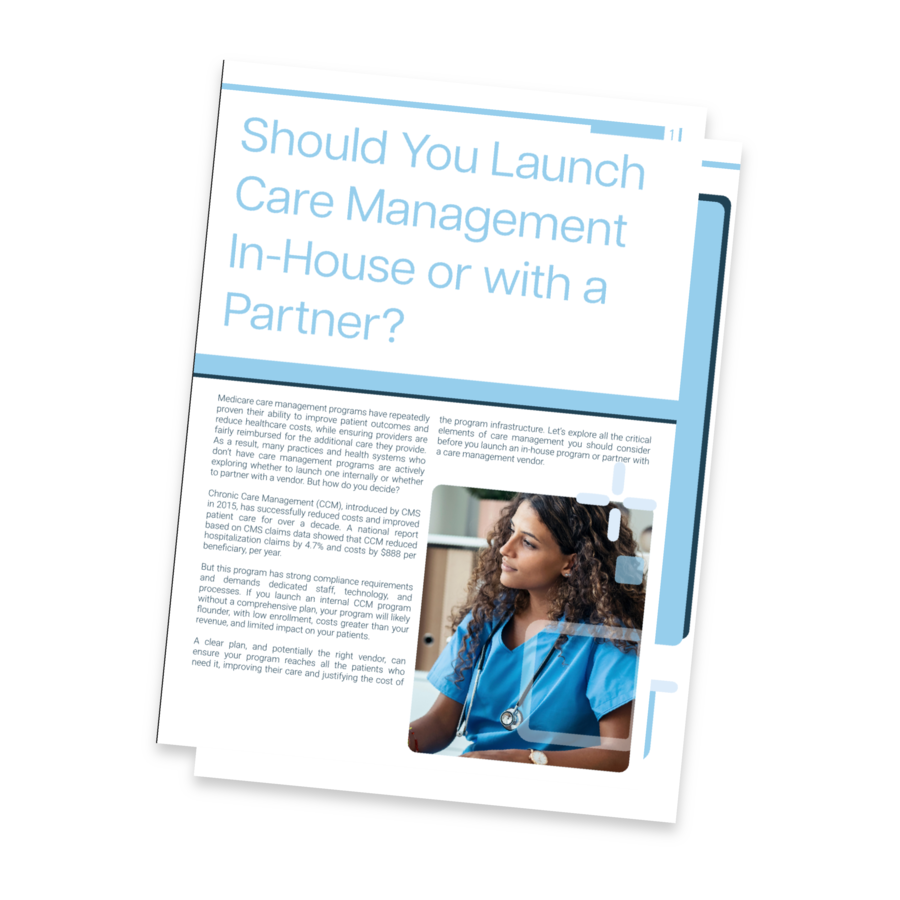
Talk with a ChartSpan Representative Today!
Our team is ready to help you improve patient care and outcomes.
Blog
6 Benefits of Patient Education in Improving Health Outcomes
Regularly examining patients is a crucial part of preventing diseases, but truly effective preventive care starts with patient education. When patients have a clear understanding of their health and the steps they can take to protect it, they’re better equipped to recognize symptoms early on, follow through on care plans, and make decisions that support long-term well-being.
Patient education is more than just information-sharing. It’s an essential strategy for strengthening the patient-provider relationship, improving communication, and giving individuals the tools they need to manage their health between visits. And as care models continue to shift toward value-based approaches, it’s becoming even more critical for improving patient outcomes.
In this article, we’ll explore what patient education looks like in practice, why it’s especially important for chronic disease management, and how providers can integrate it into their daily workflows. We’ll also highlight the role patient education plays in improving health outcomes—and how care management programs help make that possible.
What is patient education?
Patient education is the ongoing process of helping individuals understand their health conditions, available treatments, and how to manage their care effectively. By empowering patients to take a more active role in their health and adhere to care plans, education supports stronger engagement and, ultimately, better outcomes.
Importantly, patient education isn’t a one-time task or a box to check. It works best when woven into routine workflows and delivered consistently through multiple formats over time. The most effective patient education is clear and accessible, free of medical jargon, and focused on digestible explanations rather than overwhelming details.
However, educating patients takes time and resources. Practices may need to extend appointments, develop new materials, or follow up with supplemental information. Other options include providing education between appointments, as many care management programs do. But that strategy requires having enough staff to send patients educational materials digitally or by mail on a regular basis, or partnering with an organization who can perform those tasks.
While providing education can be challenging, over the long term, these efforts pay off in the form of improved outcomes, higher patient satisfaction, and more efficient care delivery.
6 ways patient education improves health outcomes
When patients have the knowledge and tools to understand their health and take action, the results are measurable. From strengthening treatment adherence to lowering readmission rates, patient education helps individuals stay on track with their care. And when patients are more engaged, practices benefit too, achieving better outcomes, using resources more efficiently, and improving quality performance under value-based care models.
1. Improved patient engagement
Patient education lays the groundwork for stronger engagement by giving individuals the information they need to take an active role in their health. When patients understand their diagnosis, what steps they can take, and why their care plan matters, they’re more likely to engage—not just during appointments, but in daily life. Education also creates opportunities for dialogue, allowing patients to ask questions, raise concerns, and participate in shared decision-making.
Care management programs like Chronic Care Management (CCM) and Advanced Primary Care Management (APCM) include care goals, care plans, and a dedicated care manager to help each patient stay engaged. Patients receive education on their conditions and the opportunity to help create their own care goals and care plan. This sense of involvement often leads to deeper commitment and better follow-through. Whether it’s tracking symptoms, managing medications, or making lifestyle changes, informed patients are more likely to stay connected to their care and invested in their long-term health.
Read further: The Provider’s Guide to Patient Engagement
2. Better treatment adherence
One of the most immediate benefits of patient education is improved adherence to prescribed treatments. Patients who understand the purpose behind each medication or therapy and the risks associated with skipping it are more motivated to follow their plan consistently. Education also helps patients overcome common barriers to adherence, such as fear, confusion, or misconceptions about the side effects.
When patients know what to expect and how to navigate their treatment, they’re more confident and compliant. This reduces the risk of setbacks and complications, particularly for those managing chronic conditions where consistency is critical to avoiding escalation.
Learn more: How to Reduce Medication Non-Adherence with CCM
3. Informed decision-making
Educating patients ensures that decisions about care aren’t made in the dark. When individuals have access to clear, accurate information about their condition, treatment options, and potential outcomes, they’re better prepared to weigh choices and make decisions that reflect their goals, values, and lifestyle.
This not only empowers patients but supports providers, too. With a better-informed patient population, clinical conversations become more productive and care plans are more likely to align with what patients are actually willing and able to do. The result is a more collaborative, transparent process that leads to higher-quality care.
4. Bolstered trust
Education helps build the foundation of a strong provider-patient relationship—one rooted in trust, communication, and mutual understanding. When patients feel that their provider is taking the time to explain things clearly and listen to their concerns, they’re more likely to trust the care they receive. That trust, in turn, improves compliance, comfort in asking questions, and satisfaction with care provided.
A patient who trusts their provider is also more likely to stay with the same practice, return for preventive care, and report positive experiences. These softer metrics, like communication, continuity, and patient satisfaction, often yield measurable improvements in outcomes and quality ratings.
5. Earlier diagnosis and treatment
Educated patients are more likely to recognize early warning signs and seek care before a condition becomes serious. When individuals understand what symptoms to watch for and how to monitor chronic conditions at home, they’re better equipped to flag concerns promptly. This can lead to earlier diagnoses, faster interventions, and fewer avoidable complications.
For providers, this proactive patient behavior means fewer emergency visits, less demand for acute services, and more opportunities to intervene when treatment is most effective. It also helps shift care toward prevention rather than crisis management.
Care management programs can assist with early, proactive care by allowing patients to call the 24/7 care line when they have symptoms but aren’t sure how serious those symptoms are. The care manager can perform triage and direct patients to the appropriate level of care, whether that’s making an appointment with their provider, going to the ER, or monitoring symptoms at home.
6. Lower readmission rates
Patient education plays a key role in reducing hospital readmissions by helping individuals manage their recovery effectively after discharge. When patients understand their discharge instructions, adhere to medication schedules, and attend follow-up appointments, they’re far less likely to return to the hospital unnecessarily. This is especially important for patients with complex or chronic conditions who are at higher risk for complications after care transitions.
Beyond improving outcomes, lower readmission rates also translate into more efficient resource use and cost savings. Fewer preventable hospital visits mean less strain on emergency departments, fewer redundant tests or procedures, and stronger performance under value-based care programs that reward quality over quantity.
For this reason, CMS has made discharge management, including patient education, a core component of their Advanced Primary Care Management program. Care managers must reach out to patients after a hospital or other inpatient discharge to provide educational materials, ensure patients have needed medications and resources, and encourage patients to connect with their provider.
Why does patient education matter for chronic conditions?
Chronic conditions require ongoing daily management. These conditions are often complex, with treatment plans that evolve with clinical guidelines. At the same time, patients with chronic conditions may face barriers such as low health literacy, limited access to care, or confusion about their diagnosis and medications. Without clear, continuous education, it’s easy for patients to feel overwhelmed, which can lead to missed medications, delayed interventions, or preventable complications.
That’s why patient education is a core component of programs like Chronic Care Management and Advanced Primary Care Management. These models are designed to support patients beyond the clinical setting by providing regular check-ins, self-management guidance, and resources for their specific conditions. With the right support in place, practices can offer patients the ongoing education needed to understand their conditions and stay engaged in their care.
ChartSpan helps make this possible by delivering condition-specific resources and a dedicated care team, available 24/7, that supports practices in educating and empowering patients with chronic conditions.
How providers can educate patients on their conditions
While care managers and nurses often take the lead on day-to-day education, providers are ultimately responsible for making sure patients understand their condition and how to manage it. That responsibility goes beyond delivering instructions—it means adapting education to each patient’s learning style, limitations, and needs.
Effective education is patient-centered, practical, and reinforced over time. You can use the following strategies to support understanding, build trust, and help patients become more involved in their care.
- Collaborate with patients to set meaningful care goals, helping them understand why the goals matter and how to reach them.
- Deliver multi-modal education, using a mix of phone calls, text messages, emails, print materials, and videos to meet patients where they are.
- Set SMART goals customized to each patient’s condition, lifestyle, culture, and socioeconomic needs, adjusting them over time as needs change.
- Use the teach-back method to confirm understanding, especially when reviewing treatment instructions or at-home care routines with patients or caregivers.
- Offer materials in multiple languages and accessible formats to accommodate physical, cognitive, or literacy-related limitations.
- Review materials with patients, walking through key points, clarifying any confusion, and inviting follow-up questions.
- Show empathy and create space for two-way communication, encouraging patients to ask questions, discuss feelings, and share concerns.
- Reinforce education during follow-ups by revisiting key topics and checking in on comprehension and progress.
Partnering with a care management provider like ChartSpan gives your practice access to a dedicated care team that can support and extend your patient education efforts. Because care managers reach out to patients on a regular cadence, they often have more opportunities to engage in patient education. From setting personalized SMART care goals and providing clinician-reviewed resources to delivering ongoing education and answering follow-up calls, CCM and APCM programs ensure that patients receive the consistent, clear communication they need to manage their conditions and stay connected to their care.
Under CCM, patients receive support every month; under APCM, the cadence is adjusted to their needs. With both programs, however, patients have access to a 24/7 care line where they can ask questions and receive educational materials at any time.
Patient education examples
There’s no single right way to educate patients; strategies should be personalized to their condition, goals, and needs. Below are a few real-world examples of how providers and care managers can deliver effective education for chronic conditions like hypertension, diabetes, and COPD. Please note these are just examples, and patients’ individual needs will vary.
Hypertension (high blood pressure)
- Blood pressure log with goal ranges: Providing patients with a simple tracking sheet or digital app that shows target ranges and prompts them to record daily readings helps them understand what their numbers mean and why consistency matters. This approach educates patients on recognizing when their blood pressure is elevated, identifying triggers like stress or sodium, and understanding when to contact their provider.
- Low-sodium diet guidance with label-reading tips: Rather than simply saying to “cut back on salt,” care managers and providers can walk patients through how to read nutrition labels for sodium content, using visual aids or sample meal plans. This practical, skill-based education helps patients apply what they’ve learned in real-life situations like grocery shopping or meal prep, making dietary changes more approachable and sustainable.
Learn how to manage chronic hypertension with CCM →
Type 2 diabetes
- Ongoing A1C tracking and encouraging self-monitoring: Providers or care managers can routinely review a patient’s A1C levels and use those touchpoints to reinforce self-monitoring habits and encourage questions. Helping patients track their A1C over time, and understand how lifestyle changes affect those numbers, builds long-term engagement and supports better glycemic control.
- Educational handout and follow-up call on food choices: Sending patients a clear, visually engaging digital or paper guide to how carbohydrates affect blood sugar, paired with calls from a nurse or care manager, makes nutrition guidance more accessible and actionable. The conversation gives patients a chance to ask questions and identify realistic dietary changes based on cultural and financial considerations.
COPD (chronic obstructive pulmonary disease)
- Inhaler technique training with video follow-up: Teaching proper inhaler technique during an appointment and reinforcing it with a short video sent through the patient portal or by text or email helps address one of the most common gaps in COPD management. Visual repetition increases retention, reduces misuse, and ensures patients are actually receiving the full benefit of their medication.
- Color-coded symptom action plan: Giving patients a color-coded action plan that outlines what to do as symptoms change—green for stable, yellow for warning signs, and red for emergencies—empowers them to act early and appropriately. This helps patients avoid worsening symptoms and unnecessary hospital visits by recognizing when to adjust medication or contact their care team.
These are only suggestions, and educational materials and techniques should be adjusted to each patient. However, every patient can benefit from consistent, reliable education from their provider and care manager.
How to tie patient education into your workflow
To be effective, patient education shouldn’t be treated as a separate task—it should be embedded into everyday workflows. That starts with making education part of routine outreach. Regular check-ins, whether through Chronic Care Management, Advanced Primary Care Management, or less structured follow-up calls, are ideal opportunities to assess understanding, revisit goals, and share timely information. Ensuring your practice is staffed to support these touchpoints, or partnering with a care management organization with their own staff, is key to keeping education consistent and sustainable.
Education should also be available when patients reach out on their own. If a patient calls with a question about their condition or treatment plan, your team should be prepared to answer it or offer another resource, like a 24/7 care line, during your off hours. Keeping your website, patient portal, and social media channels up-to-date with helpful, patient-friendly information also supports self-education by helping patients find reliable answers on their own.
ChartSpan’s Chronic Care Management and Advanced Primary Care Management programs can ease the burden of continuous outreach by offering patients 24/7 care lines and monthly check-ins from care managers. With a care team managing between-visit education and support, your in-person appointments become more focused and effective, giving you more time to review important information, address concerns, and build patient understanding face to face.
How ChartSpan supports patient education
Patient education takes time, coordination, and consistency, especially for individuals managing chronic conditions. ChartSpan helps practices deliver that education effectively through services that support both patients and providers.
ChartSpan’s Chronic Care Management and Advanced Primary Care Management programs offer regular check-ins from care managers, 24/7 care lines for questions between appointments, and access to clinician-reviewed resources written at or below an 8th-grade reading level. Care teams can also communicate directly with a patient’s legally appointed contact and share practical, condition-specific information such as recommended exercises, diet tips, and medication reminders with the patient or their loved one. By supporting patient understanding and improving adherence, ChartSpan helps your practice capture reimbursements tied to better outcomes and provide better patient care.
Talk to an expert today to learn how ChartSpan can help your practice deliver more effective patient education and make it a seamless part of your care model.
Subscribe for More Insights
Get valuable resources delivered straight to your inbox.
"*" indicates required fields






